By Gerard Huissen

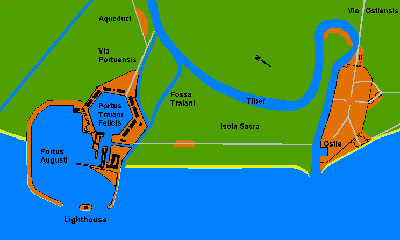
antiquity.
The Greek text 'This is a place without fear' on the mosaic above is still legible at the necropolis of Isola Sacra, the cemetery of ancient Portus. Depicted here are ships sailing into the harbor with the famous lighthouse in the background. Here ships were safe from the perils of the great sea.
But the location of this mosaic makes archaeologists suspect that there might be another thought behind these lines; for the mosaic lies in front of the entrance of a tomb. It may be possible that we are dealing here with the deeper feelings of the tomb owner. Does not the fear of death only cease when when have passed away? Perhaps the builder is also telling us, using a beautiful metaphor, that fear ends here on this place, here on threshold of death. In any case, it was important enough for him to spend a considerable sum to build this place.
Thus we find, particularly in graveyards and cemeteries, tangible evidence of human concerns and preoccupations, of their work lives and the lives of their families. In the whole of Ostia or Portus, one finds scarcely any mention of the profession of the owner on the walls. But with the great transition in sight, one might survive in the memory of the living through one’s final resting place. Perhaps that is why so many tomb inscriptions and pictures depict the deceased, visions of the afterlife and what he or she was involved in life.
Who were they?
Isola Sacra, the Holy or Sacred Island, is an artificial island formed by the sea, the river Tiber and a canal excavated by Trajan south of the city of Portus, which connected the sea with the Tiber. Here the ancient necropolis is located.
What every visitor to the necropolis immediately sees are the many terracotta reliefs on the tomb walls that often depict the profession of the owner.
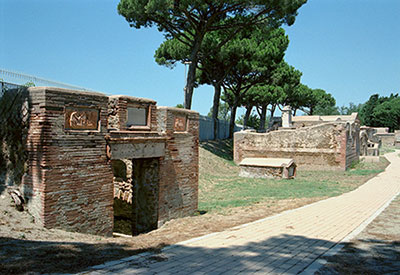
We find a good example of this at tomb 100, probably that of two medical doctors. On the left, we see a male doctor treating a patient’s leg with as well as lots of medical equipment.
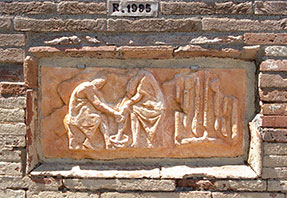
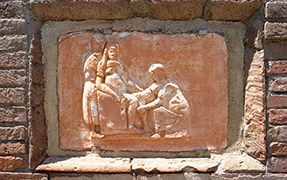
The inscription on the wall of the tomb tells us that this tomb had been built by Scirbonia Attice for herself and her husband Marcus Ulpius Amerimus, for her mother, for a certain Diocles and for her freedmen, together with their descendants. So far a typical text, but then, at the end we see a glimpse of their last thoughts. They tell us: “with exception of Panaratus and Prodocia”. We will never know who Panaratus and Prodocia were, but one wonders why they were specifically excluded from this tomb.
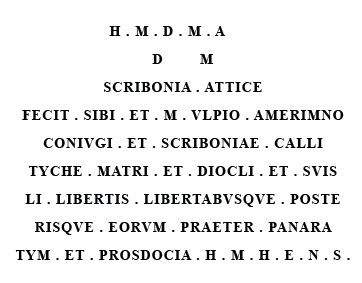
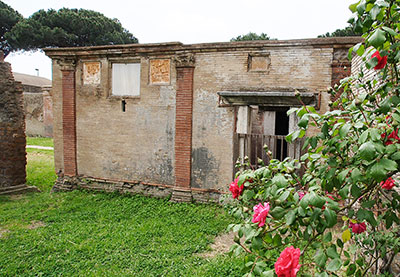
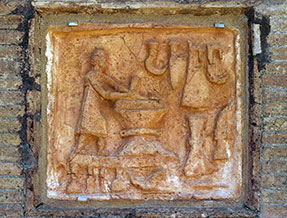 Tomb 29. The left relief
Tomb 29. The left relief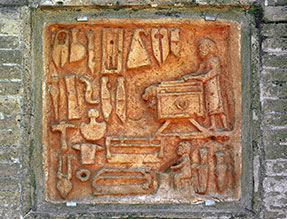
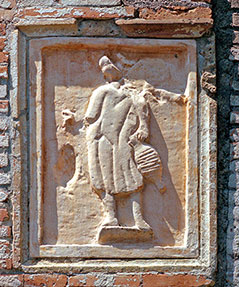
The next tomb on the necropolis, tomb 30, shows a relief depicting an Aquarius, or watercarrier. Next to the watercarrier, who carriers an amphora, there are two small amphoras bricked into the wall.
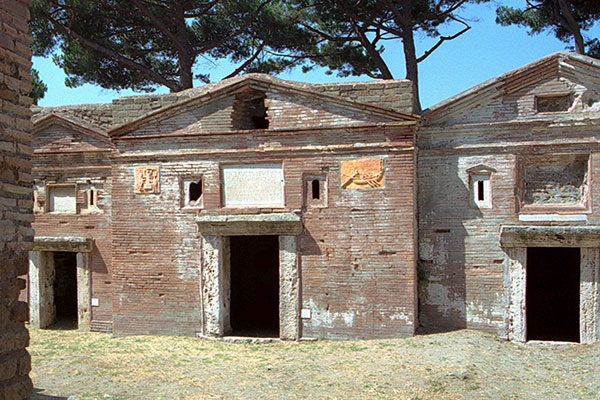
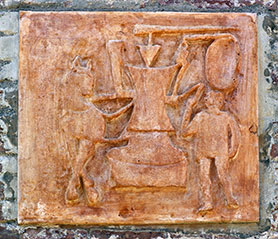
Of course, how the life of a tomb owner was depicted and what kind of decoration was used depended strongly on the wealth of the owner or of his family. At the necropolis of Isola Sacra we find very large burial complexes, like tomb 47 with a tremendous waterfall, as well as very small ones like this tiny pyramid.
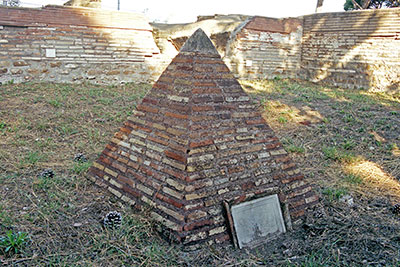
The latter was a tomb meant for the ashes of Caius Annaei Attici. On the tomb we read the following:
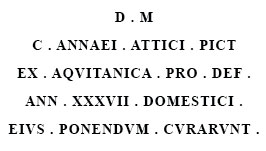
Besides his name we see the characters PICT EX AQVITANIA. Professor Guido Calza, the leader of the excavation in the ninteen‐thirties suggested that we read the characters “PICT” as “PICTORIS” and thus, this was the tomb of a painter. But modern archaeologists, like Ida Baldassarre, interpret this these characters as PICTONIS (the current city of Potiers) in the french province of Aquitania. Perhaps the man wasn’t a painter but a Frenchman.
The relatives and their grievances
The less fortunate, as well as slaves and freedmen, were sometimes able to obtain a resting place inside the tomb of their owner or benefactor. Others were buried in the so called “field for the poor”. But poor or not, there was always an inscription. Often, one can almost perceive the grief of the relatives.
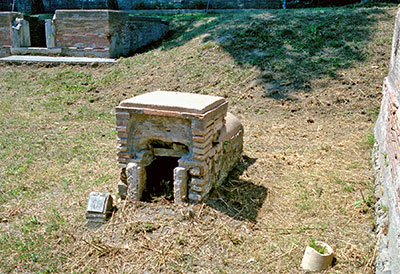
Isola Sacra
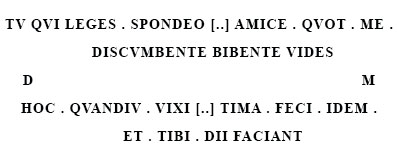
“Thou, friend (6 characters are missing) who shall read this, while I am lying down and who will see this during his life, I have done this when I was alive (12 characters are missing) and may the gods do this also to you.”
ego memini quenda[m] crissasse puella[m] cuius cinere aurea terra tegat
“I remember touching the buttocks of a certain girl, whose ashes cover the golden earth".
The question is, of course, was this a late declaration of love or an attempt to give the girl a bad name after she died? Unfortunately, the graffito is now lost.
The implementation and decoration of a tomb can also tell us something about the owner; about the gods he worshipped in this life as well as the kind of life he expected in the hereafter.
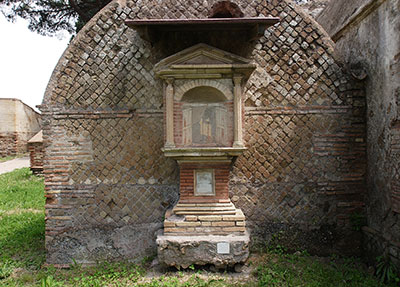
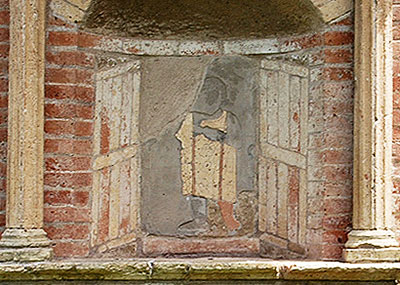
The owner of tomb 56 even gives us a look around the corner of his heaven. This was, by the way, not unusual.
Sometimes we see the owners themselves appear in the tomb; most often, as part of the wall paintings or, in a single case, with a bust and even as a complete statue.
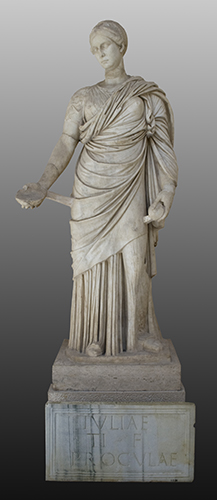
from tomb 97
At Isola Sacra, we are afforded a glimpse into the lives of the citizens of antiquity; the rich, the famous, the important, as well as the poor. In some sense, they rescue themselves from oblivion even after 2000 years. Might we do the same?
(Translation made by Robert G. Harp)
Sources:
'Necropoli di Porto', Ida Baldassarre, Irene Bragantini, Chiara Morselli, Francia Taglietti, Roma 1996
'Necropoli Nell'Isola Sacra', Guido Calza, 1940
'Inscriptions du Port D'Ostie', Hilding Thylander, 1951
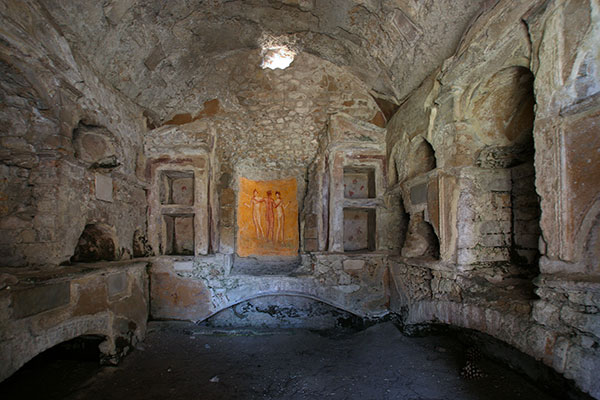
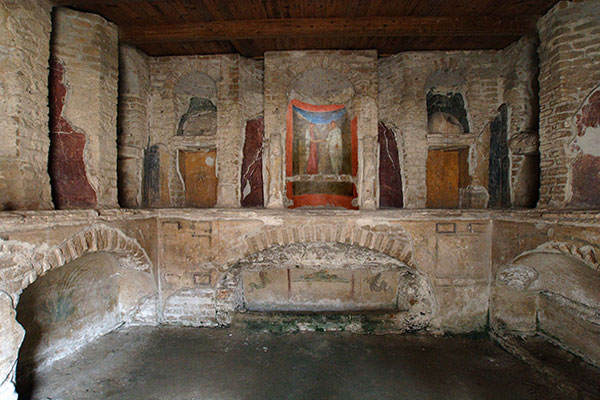






 We are committed to providing versions of our articles and interviews in several languages, but our first language is English.
We are committed to providing versions of our articles and interviews in several languages, but our first language is English.